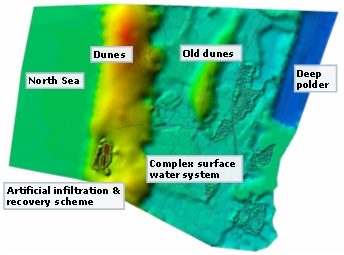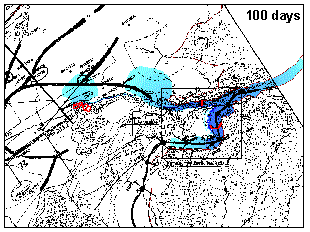Addition of salt migration to a simulationprogram for groundwater flow
Esther van Baaren
Site of the project:
Royal Haskoning
Hoofdweg 490
3067 GK Rotterdam
start of the project:
August 2006
In December 2006 the
Interim
Thesis has been appeared
and a
presentation has been given.
The Master project has been finished in June 2007 by the completion of
the
Masters
Thesis
and a final presentation has been given.
For working address etc. we refer to our
alumnipage.
Summary of the master project:
Introduction
Triwaco
is a software package for hydrological model simulations. The
development started 30 years ago with a collection of programs for
groundwater flow. Thereafter many options are included and a graphical
user interface has been added. The package has been developed and
maintained by Royal Haskoning and is used by water control company and
institutes in The Netherlands and abroad.

Triwaco offers an integrated modelling environment for unsaturated,
saturated, drainage/infiltration and surface water flow.
The simulator is suitable for the specific circumstances in The
Netherlands and takes into account the density variations due to salt
concentrations in the groundwater.
However, the simulator is not able to simulate the instationary
development of the salt
concentrations. There is a need to include this in order to
predict the effects of the expected sea water level.

Rise in groundwater level after the first inflow in the dam and the
subsequent artificial recharge (Omaruru, Namibia).
Technical background
Triwaco subdivided the underground in domains based on geological layers. The
lateral groundwater flow is computed per layer by a finite element
method based on triangular elements. The vertical transport
between layers is done by a finite difference method.
The right-hand-side term is used to implement the transport between
the layers. This mixture of finite element and finite difference
methods is very suitable to simulate the groundwater flow.
The question is if this approach also works for the salt migration in
the groundwater. To answer this question we consider two steps:
-
Determine the best numerical method to simulate salt migration on a
finite element grid, which consists of triangular elements;
- Implement this approach in a simulation program for
Triwaco.
The Triwaco-simulation programs are written in Fortran,
mostly -77 with some extensions to Fortran90.

Contact information:
Kees
Vuik

Back to the
home page
or the
Master students page of Kees Vuik


![]()
![]()